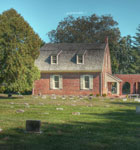The Scene
The Camden Friends Meeting House is off the beaten path, about a half mile from the center of the small town of Camden, Delaware, which has a population of just 2,100. On one side is a historic town, developed enough to boast a Wal-Mart; on the other is rural farm country where corn and soybeans are grown. South of New Jersey and north of Washington, DC, the city of Camden faces harsh East Coast winters, hot summer sun, and late-summer hurricanes.
The Setup
Prior to the Civil War, the Camden Friends Meeting House, a place of worship owned by the Religious Society of Friends (or, Quakers), was instrumental in the Underground Railroad and the fight to abolish slavery. Re:Vision Architecture was asked to renovate the meeting house and the annex building next to it—which is used for administrative offices, education, and other events—and to get as “sustainable as the budget would allow” without damaging or destroying the property’s 207-year-old historic value. After an extensive review of the existing annex building, Re:Vision had it dismantled shingle by shingle, nail by nail, and window by window, reusing everything possible and grinding and recycling the remaining material into new components. While it wasn’t the client’s original goal, in the end Re:Vision achieved green building’s holy grail—net-zero energy and net-zero water—and the building was certified LEED Platinum in 2011.

This meetinghouse left its mark on American history as part of the Underground Railroad. Today, when it comes to the environment, the net-zero house of worship is leaving no mark at all.
The Strategy
 At first, the architects were looking to salvage as much as they could out of the existing structure, says Scott Kelly, principal of Re:Vision Architecture and recipient of AIA Philadelphia’s 2011 Young Architect Award. “We discovered there was no way to keep the 1950 concrete masonry unit, with no insulation and a host of issues that came with that time period,” he says, “so we razed the entire building and redid it as responsibly as possible.” A full 97.5 percent of the old building was recycled or reused, including trusses, light fixtures, and exterior windows, which were moved to interior hallways.
At first, the architects were looking to salvage as much as they could out of the existing structure, says Scott Kelly, principal of Re:Vision Architecture and recipient of AIA Philadelphia’s 2011 Young Architect Award. “We discovered there was no way to keep the 1950 concrete masonry unit, with no insulation and a host of issues that came with that time period,” he says, “so we razed the entire building and redid it as responsibly as possible.” A full 97.5 percent of the old building was recycled or reused, including trusses, light fixtures, and exterior windows, which were moved to interior hallways.
Today, the meeting house and annex share a closed-loop geothermal heating-and-cooling system, and the annex boasts a 12-kilowatt photovoltaic array that works in conjunction with its passive-solar design. Soy-based foam insulation and a SIP roof are additional ultra-green elements of the new building. To conserve water, the annex uses a tankless water heater, a 2,000-gallon rainwater cistern, and vegetated swales to handle storm water. Perhaps its most unique eco-friendly feature is its parking area, which is paved with discarded clamshells from local restaurants.
“We designed the building so that the architecture itself does most of the heavy lifting rather than the mechanical systems, making it easier to get to zero energy,” Kelly explains, noting that in the new annex’s first year of operation, it produced 158 percent of its energy, the excess used to power the meeting house and parking-lot lighting.
Part of the project’s success can be attributed to the contractor, Boss Enterprises. “We never would have been able to recycle so much if they hadn’t been as passionate as they were,” Kelly says. “They found a way to get the ground-up drywall used by local farmers as a soil amenity.” And mechanical engineer In Posse, a subsidiary of AKF, worked with Re:Vision to design the most efficient energy and water systems, resulting in water harvested from rain that is “purified to a level cleaner than standard drinking water,” Kelly says.
The Camden project was given the Net Zero Energy Award by the Northeast Sustainable Energy Association in 2011, and Re:Vision, which is headquartered in Philadelphia and has an office in Berkeley, California, is currently working on three other net-zero-energy and net-zero-water buildings that are all pursuing certification through the Living Building Challenge.

